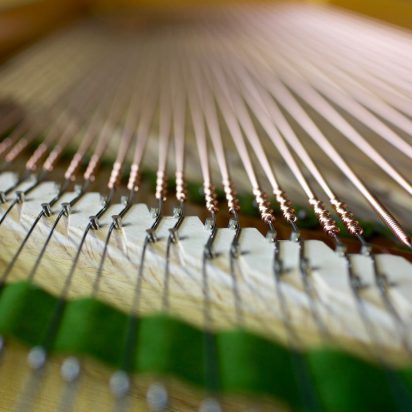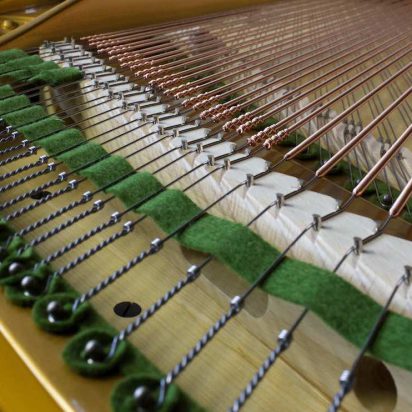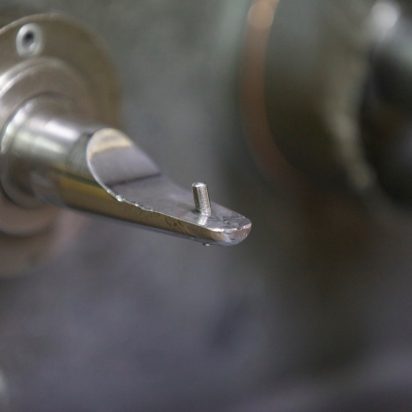
For an accurate replacement of all bass strings, when ordering complete sets we request you to measure the fixed points (front bridge pins and v-bar/agraffes) in the instrument; for individual strings measure the beginning and end of the copper windings (see also FAQ).
The following explains in detail both types of order as well as various methods of ordering an entire set of bass strings:
Bass complete:
There are various ways to order a complete set of bass strings:
1. The most accurate method of ordering:
Already more than 95% of our customers measure the required A and B lengths with our special tape measure (order here free of charge) in the instrument; then enter the data in the printed order form and send the handwritten data with a smart phone photo, a scan per email or fax. You can also enter the data in the online form and click on ‘send’.

A-measurement: From hitch pin to front bridge pin
B-measurement: From hitch pin to v-bar/agraffe
In addition, with lesser known instruments, enter the overall diameters of the thickest and thinnest singles, bi-chords and tri-chords (see example). If you want a set of replacement strings spun according to your own scale design then of course you can enter the complete steel and copper specifications.
In the event of not having our tape measure to hand, please measure from the front edge of the hitch pin (not including the 4mm diameter of the pin) – this will then correspond perfectly to our measuring system.
2. The traditional method of ordering:
Send us the old bass strings – threaded on a wire in correct order – in a box per post. Include the name of the instrument and the respective numbers of singles, bi-chords or possibly tri-chords.
Please note: do not cut the steel core directly behind the end of the copper, but several centimetres behind the deformation left by the v-bar or agraffe in the string.
In this way the new bass strings will fit more accurately, because we won’t have to follow the old copper end points as orientation.
3. The least accurate method of ordering:
Make a paper pattern of the bass strings in the instrument and send it per post.
Please note: include some of the old strings (first and last in each section) in order to eliminate any inaccuracy from the paper pattern.
Individual strings:
To order an individual string we need at least four measurements to replicate a single string with reasonable accuracy:
-Eye to copper begin
-Eye to end of copper or total length of copper
-Steel core diameter
-Overall diameter
To make the individual string as accurate as possible, further factors need to be considered:
– Were the measurements taken under tension (string in the instrument) or non-tensed (string removed)?
– Were the measurements made using our tape measure (lengths without hitch pin diameter) or taken from the back of the hitch pin?
– The type of eye: German eye, double German eye (or hand eye), French eye (machine eye.) NB: The hitch pin eye is also called a loop or knot. (How long is the eye?)
– Round or hexagon wire?
– The form of the copper ends.
– If you require a recalculation of the string tension, give the name of the note
– Customer’s name for better identification of the new string
We have attempted to accommodate these many details in the order form…you decide with your info how accurate the new string will be…but the four minimum specifications are essential.
Of course, you can merely give the overall thickness and we will select a steel core size according to our experience. With single strings this is no problem … with bi-chords difficulties can occur when tuning if the partner string has a different core diameter. We recommend, in the case of bi-chords, replacing both strings.






